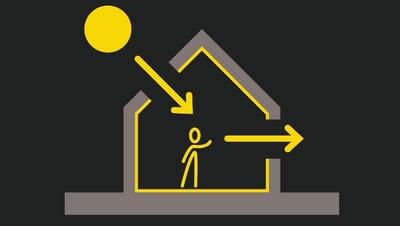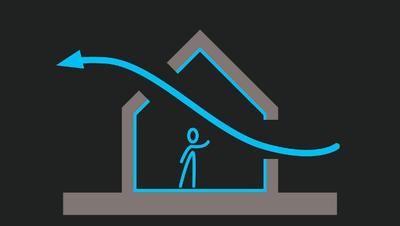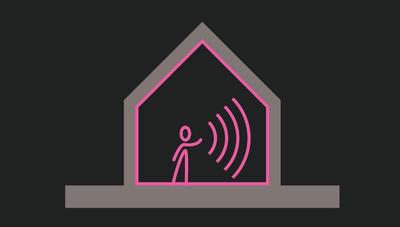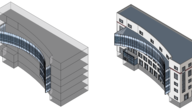You are here
Buildings are designed for people, and those people are trying to accomplish a task – whether it’s raising a family, running an office, or manufacturing a product. The building needs to keep people comfortable, efficient, healthy, and safe as they set about their task.
Green design seeks to create buildings that keep people comfortable while minimizing negative environmental impacts.
Thermal Comfort
|
|
Maintaining a person’s thermal comfort means ensuring that they don’t feel too hot or too cold. This means keeping the temperature, humidity, airflow and radiant sources within acceptable range. |
Why it’s important
Creating comfortable conditions is one of the biggest uses of energy in buildings and it is also critical to the happiness and productivity of its users. Often factors such as airflow and radiant temperature are overlooked in a design, leading to higher energy use and occupancy dissatisfaction.
Metrics
To keep people comfortable you need to provide the right mixture of temperature, humidity, radiant temperature and air speed. The right level of these variables depends on what activity is occurring, how active the people are, and what they are wearing. Everyone has slightly different criteria for comfort, so comfort is often measured by the percentage of occupants who report they’re satisfied with the conditions.
Design Strategies
Some ways to keep people comfortable are to use the sun’s heat to warm them, use the wind or ceiling fans to move air when it’s too warm, and keeping surrounding surfaces the correct temperature with good insulation. HVAC equipment like boilers, fans, and heat exchangers can temper the air temperature and humidity, but surface temperatures and moving air have to be considered too.
Learn more about human thermal comfort and passive design strategies to help.
Visual Comfort
|
|
Maintaining visual comfort means ensuring that people have enough light for their activities, the light has the right quality and balance, and people have good views. |
Why it’s important
Good lighting helps create a happy and productive environment. Natural light does this much better than electric lighting. Having good views and sight-lines gives people a sense of control of their environment and provides a sense of well-being.
Metrics
Good lighting is well-distributed, is not too dim or too strong, and uses minimal energy. Lighting is often measured either by the amount of light falling on a surface (illuminance) or the amount of light reflecting off of a surface (luminance). These are objective measures, but how people experience this light is often subjective (i.e. are they comfortable?, do they experience glare?). Good visual comfort also generally means that as much of this light is natural light as possible. Humans are hard-wired to like the sun’s light and it saves energy.
Design Strategies
Daylighting design strategies like high or clerestory windows, light shelves, and well-placed skylights can help distribute sunlight inside a space. When you do need to use artificial lights, you can reduce energy use by using efficient fluorescents or LEDs, with daylighting dimming controls, effective fixtures, and good lighting design. Good controls can automatically balance natural and artificial lighting. Most lights should have occupancy sensors.
Learn more about natural and artificial lighting and how to measure it.
Air Quality
|
|
In addition to air that’s the right temperature and humidity for thermal comfort, it’s important that air is clean, fresh, and circulated effectively in the space. |
Why it’s important
If air is too stale or is polluted, it can make people uncomfortable, unproductive, unhappy, and sick. Fresh air helps people be alert, productive, healthy, and happy.
Metrics
Fresh air requires a certain percentage of outside air circulating into spaces. Clean air requires pollutant and pathogen levels to be below certain thresholds.
Design Strategies
Air can be kept fresh with high ventilation rates, either using natural ventilation such as operable windows and skylights, or active systems such as HVAC fans and ducts. Clean air can be achieved by filtering air, by flushing spaces with fresh outside air, and by not contaminating the air with impurities from the building, such as volatile organic compounds from paints or materials.
Learn more about Indoor Air Quality.
Acoustic Comfort
|
|
Acoustic comfort means having the right level and quality of noise to use the space as intended. |
Why it’s important
People are more productive and happy when they’re not distracted by noises from outside or from surrounding spaces and occupants. Acoustic comfort is especially important for schools and office buildings.
Metrics
How humans perceive sounds and loudness is a subjective measure. However, you can create a comfortable environment by controlling objective measures like decibel level (sound pressure), reverberation time, and the sound reflection and damping properties of materials.
Design Strategies
Creating barriers and sound breaks between sources of noise is important. You can optimize room shape and size to reduce echoes and reverberation. And you can use acoustic tiles on ceilings and walls to dampen the sound.
Learn more about Acoustic Comfort.






